Assessment 1: Enterprise Leadership Essay - Management vs. Leadership
VerifiedAdded on 2022/09/12
|6
|1343
|28
Essay
AI Summary
This essay critically examines the distinctions between management and leadership, addressing how enterprise leaders can cultivate social responsibility. It begins by contrasting the roles of managers, who focus on planning and control, with leaders, who inspire and motivate. The essay highlights the challenges leaders face, such as balancing short-term goals with long-term vision, and explores various leadership styles, with an emphasis on inspirational and transformational approaches. The author discusses how leaders can learn to be socially responsible by building teams, communicating effectively, and aligning organizational goals with stakeholder expectations. The essay references key readings to support its arguments, concluding that effective leaders must balance management and leadership principles to foster a productive and socially responsible organization.
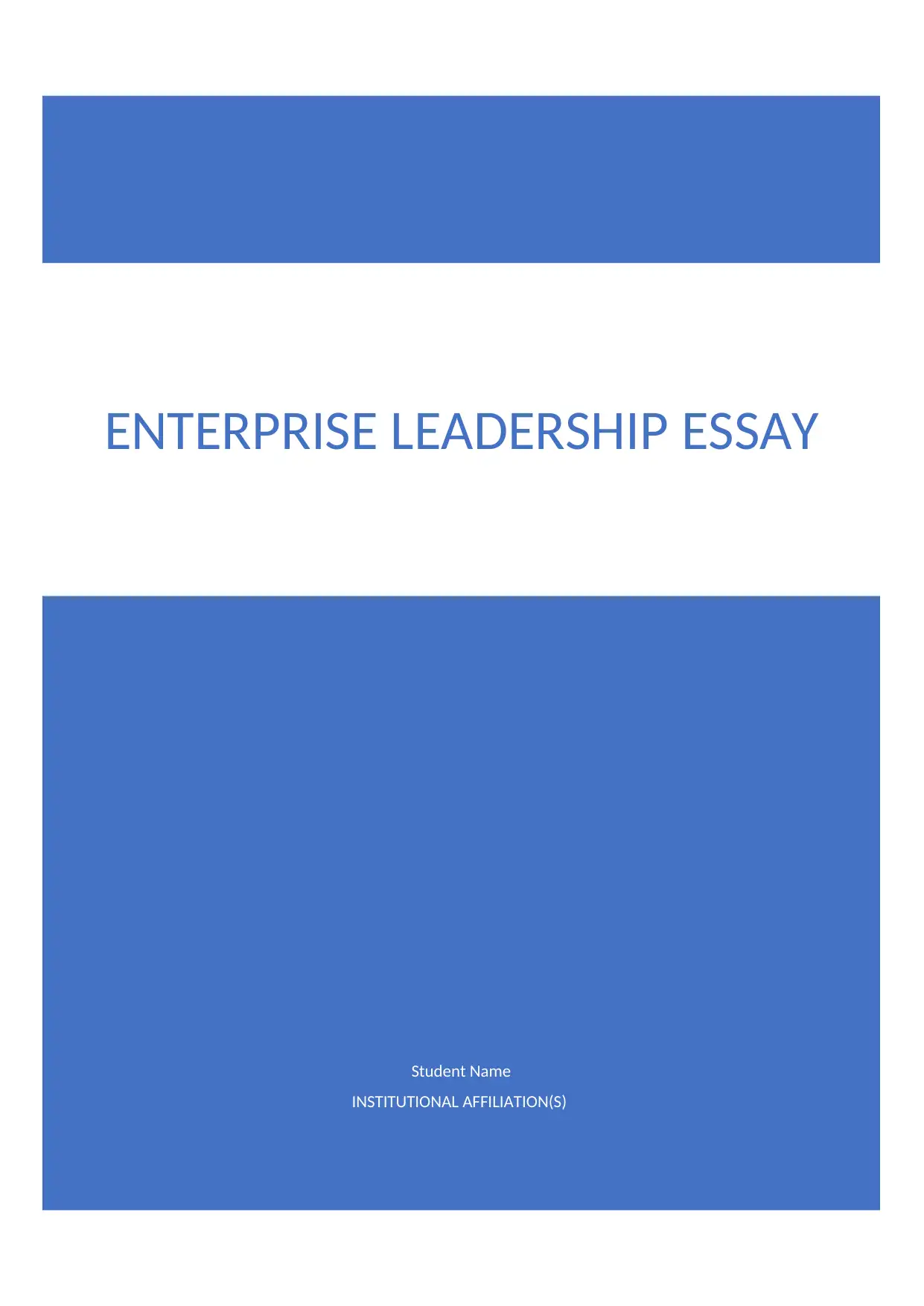
Student Name
INSTITUTIONAL AFFILIATION(S)
ENTERPRISE LEADERSHIP ESSAY
INSTITUTIONAL AFFILIATION(S)
ENTERPRISE LEADERSHIP ESSAY
Paraphrase This Document
Need a fresh take? Get an instant paraphrase of this document with our AI Paraphraser
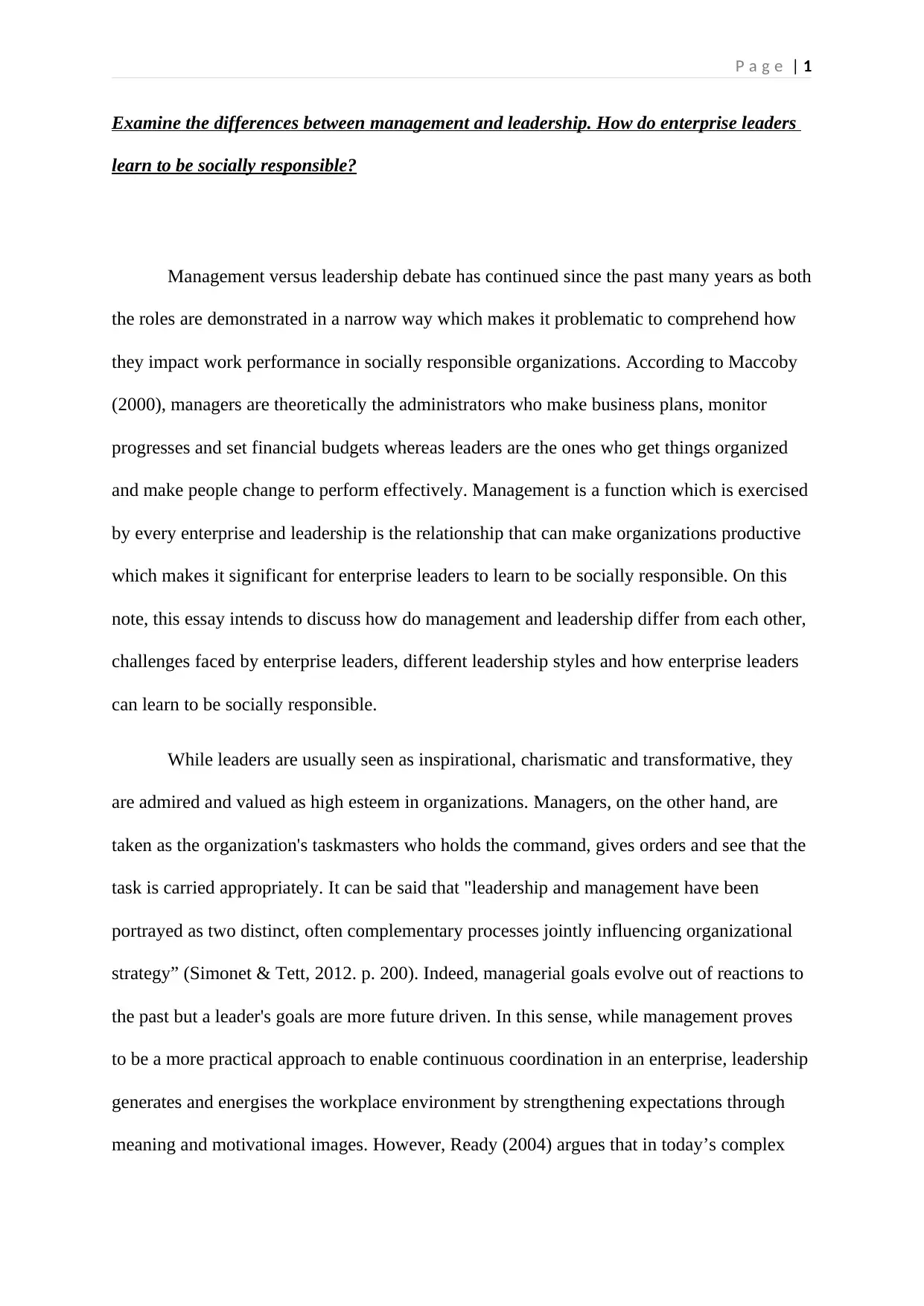
P a g e | 1
Examine the differences between management and leadership. How do enterprise leaders
learn to be socially responsible?
Management versus leadership debate has continued since the past many years as both
the roles are demonstrated in a narrow way which makes it problematic to comprehend how
they impact work performance in socially responsible organizations. According to Maccoby
(2000), managers are theoretically the administrators who make business plans, monitor
progresses and set financial budgets whereas leaders are the ones who get things organized
and make people change to perform effectively. Management is a function which is exercised
by every enterprise and leadership is the relationship that can make organizations productive
which makes it significant for enterprise leaders to learn to be socially responsible. On this
note, this essay intends to discuss how do management and leadership differ from each other,
challenges faced by enterprise leaders, different leadership styles and how enterprise leaders
can learn to be socially responsible.
While leaders are usually seen as inspirational, charismatic and transformative, they
are admired and valued as high esteem in organizations. Managers, on the other hand, are
taken as the organization's taskmasters who holds the command, gives orders and see that the
task is carried appropriately. It can be said that "leadership and management have been
portrayed as two distinct, often complementary processes jointly influencing organizational
strategy” (Simonet & Tett, 2012. p. 200). Indeed, managerial goals evolve out of reactions to
the past but a leader's goals are more future driven. In this sense, while management proves
to be a more practical approach to enable continuous coordination in an enterprise, leadership
generates and energises the workplace environment by strengthening expectations through
meaning and motivational images. However, Ready (2004) argues that in today’s complex
Examine the differences between management and leadership. How do enterprise leaders
learn to be socially responsible?
Management versus leadership debate has continued since the past many years as both
the roles are demonstrated in a narrow way which makes it problematic to comprehend how
they impact work performance in socially responsible organizations. According to Maccoby
(2000), managers are theoretically the administrators who make business plans, monitor
progresses and set financial budgets whereas leaders are the ones who get things organized
and make people change to perform effectively. Management is a function which is exercised
by every enterprise and leadership is the relationship that can make organizations productive
which makes it significant for enterprise leaders to learn to be socially responsible. On this
note, this essay intends to discuss how do management and leadership differ from each other,
challenges faced by enterprise leaders, different leadership styles and how enterprise leaders
can learn to be socially responsible.
While leaders are usually seen as inspirational, charismatic and transformative, they
are admired and valued as high esteem in organizations. Managers, on the other hand, are
taken as the organization's taskmasters who holds the command, gives orders and see that the
task is carried appropriately. It can be said that "leadership and management have been
portrayed as two distinct, often complementary processes jointly influencing organizational
strategy” (Simonet & Tett, 2012. p. 200). Indeed, managerial goals evolve out of reactions to
the past but a leader's goals are more future driven. In this sense, while management proves
to be a more practical approach to enable continuous coordination in an enterprise, leadership
generates and energises the workplace environment by strengthening expectations through
meaning and motivational images. However, Ready (2004) argues that in today’s complex
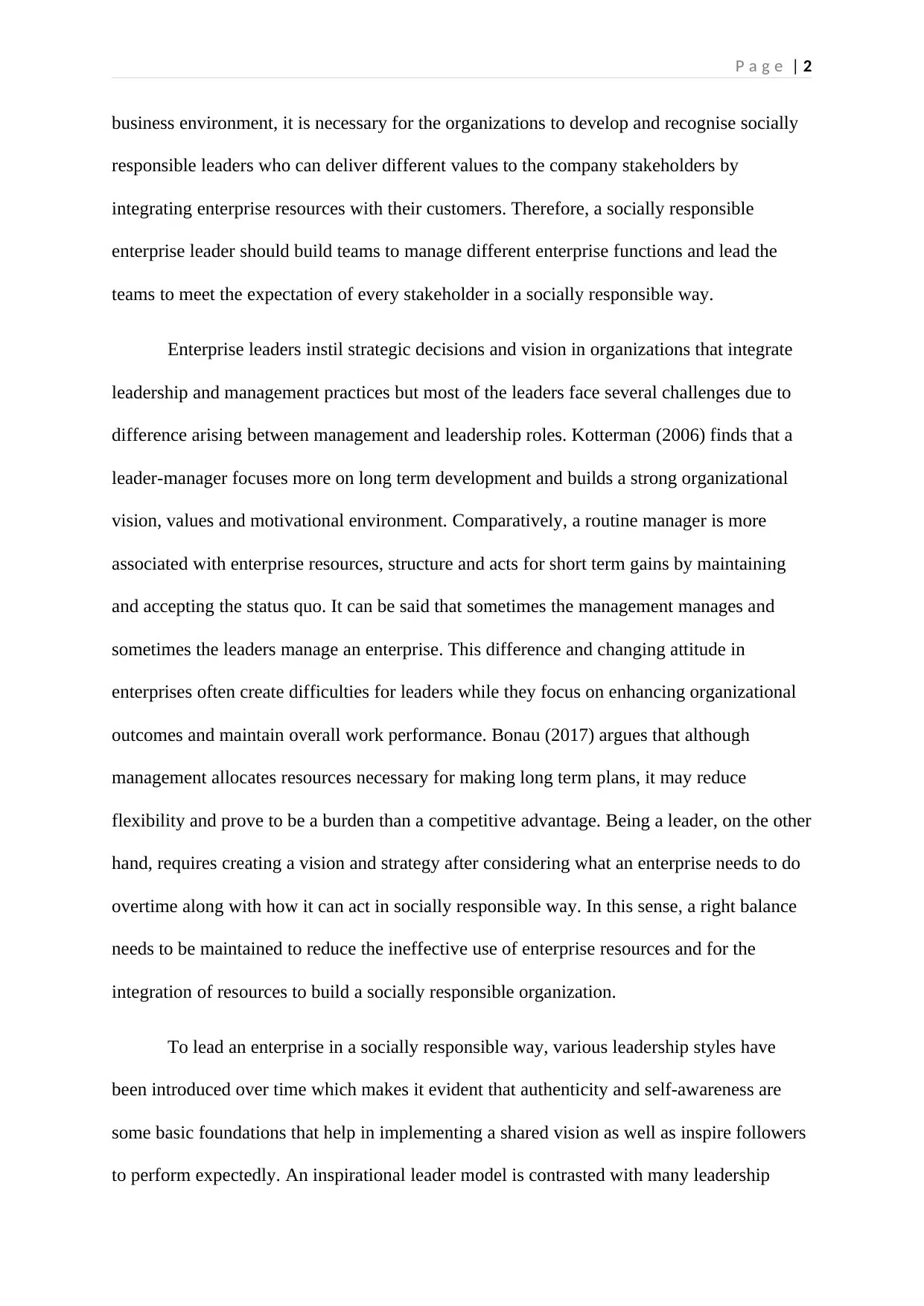
P a g e | 2
business environment, it is necessary for the organizations to develop and recognise socially
responsible leaders who can deliver different values to the company stakeholders by
integrating enterprise resources with their customers. Therefore, a socially responsible
enterprise leader should build teams to manage different enterprise functions and lead the
teams to meet the expectation of every stakeholder in a socially responsible way.
Enterprise leaders instil strategic decisions and vision in organizations that integrate
leadership and management practices but most of the leaders face several challenges due to
difference arising between management and leadership roles. Kotterman (2006) finds that a
leader-manager focuses more on long term development and builds a strong organizational
vision, values and motivational environment. Comparatively, a routine manager is more
associated with enterprise resources, structure and acts for short term gains by maintaining
and accepting the status quo. It can be said that sometimes the management manages and
sometimes the leaders manage an enterprise. This difference and changing attitude in
enterprises often create difficulties for leaders while they focus on enhancing organizational
outcomes and maintain overall work performance. Bonau (2017) argues that although
management allocates resources necessary for making long term plans, it may reduce
flexibility and prove to be a burden than a competitive advantage. Being a leader, on the other
hand, requires creating a vision and strategy after considering what an enterprise needs to do
overtime along with how it can act in socially responsible way. In this sense, a right balance
needs to be maintained to reduce the ineffective use of enterprise resources and for the
integration of resources to build a socially responsible organization.
To lead an enterprise in a socially responsible way, various leadership styles have
been introduced over time which makes it evident that authenticity and self-awareness are
some basic foundations that help in implementing a shared vision as well as inspire followers
to perform expectedly. An inspirational leader model is contrasted with many leadership
business environment, it is necessary for the organizations to develop and recognise socially
responsible leaders who can deliver different values to the company stakeholders by
integrating enterprise resources with their customers. Therefore, a socially responsible
enterprise leader should build teams to manage different enterprise functions and lead the
teams to meet the expectation of every stakeholder in a socially responsible way.
Enterprise leaders instil strategic decisions and vision in organizations that integrate
leadership and management practices but most of the leaders face several challenges due to
difference arising between management and leadership roles. Kotterman (2006) finds that a
leader-manager focuses more on long term development and builds a strong organizational
vision, values and motivational environment. Comparatively, a routine manager is more
associated with enterprise resources, structure and acts for short term gains by maintaining
and accepting the status quo. It can be said that sometimes the management manages and
sometimes the leaders manage an enterprise. This difference and changing attitude in
enterprises often create difficulties for leaders while they focus on enhancing organizational
outcomes and maintain overall work performance. Bonau (2017) argues that although
management allocates resources necessary for making long term plans, it may reduce
flexibility and prove to be a burden than a competitive advantage. Being a leader, on the other
hand, requires creating a vision and strategy after considering what an enterprise needs to do
overtime along with how it can act in socially responsible way. In this sense, a right balance
needs to be maintained to reduce the ineffective use of enterprise resources and for the
integration of resources to build a socially responsible organization.
To lead an enterprise in a socially responsible way, various leadership styles have
been introduced over time which makes it evident that authenticity and self-awareness are
some basic foundations that help in implementing a shared vision as well as inspire followers
to perform expectedly. An inspirational leader model is contrasted with many leadership
⊘ This is a preview!⊘
Do you want full access?
Subscribe today to unlock all pages.

Trusted by 1+ million students worldwide
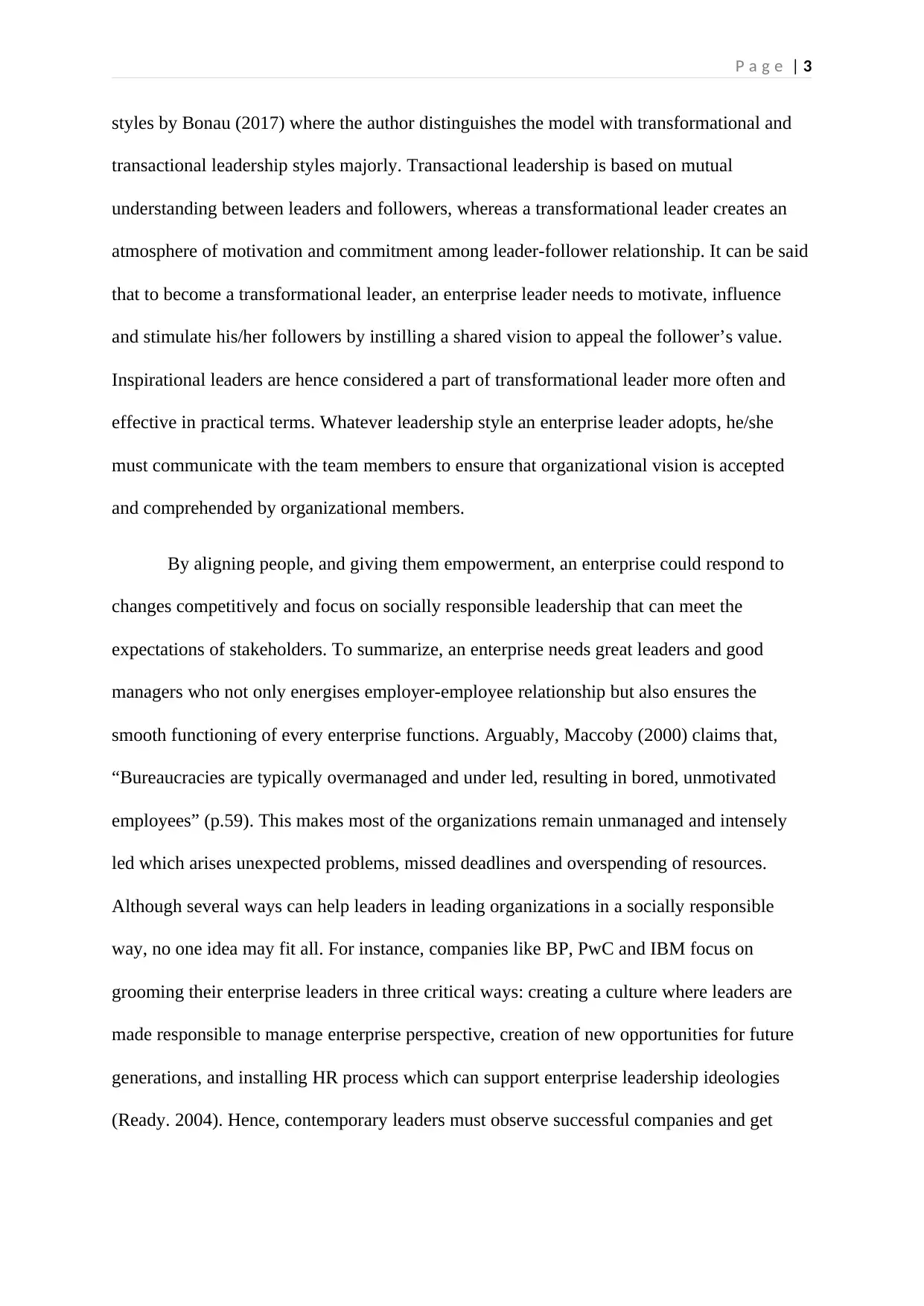
P a g e | 3
styles by Bonau (2017) where the author distinguishes the model with transformational and
transactional leadership styles majorly. Transactional leadership is based on mutual
understanding between leaders and followers, whereas a transformational leader creates an
atmosphere of motivation and commitment among leader-follower relationship. It can be said
that to become a transformational leader, an enterprise leader needs to motivate, influence
and stimulate his/her followers by instilling a shared vision to appeal the follower’s value.
Inspirational leaders are hence considered a part of transformational leader more often and
effective in practical terms. Whatever leadership style an enterprise leader adopts, he/she
must communicate with the team members to ensure that organizational vision is accepted
and comprehended by organizational members.
By aligning people, and giving them empowerment, an enterprise could respond to
changes competitively and focus on socially responsible leadership that can meet the
expectations of stakeholders. To summarize, an enterprise needs great leaders and good
managers who not only energises employer-employee relationship but also ensures the
smooth functioning of every enterprise functions. Arguably, Maccoby (2000) claims that,
“Bureaucracies are typically overmanaged and under led, resulting in bored, unmotivated
employees” (p.59). This makes most of the organizations remain unmanaged and intensely
led which arises unexpected problems, missed deadlines and overspending of resources.
Although several ways can help leaders in leading organizations in a socially responsible
way, no one idea may fit all. For instance, companies like BP, PwC and IBM focus on
grooming their enterprise leaders in three critical ways: creating a culture where leaders are
made responsible to manage enterprise perspective, creation of new opportunities for future
generations, and installing HR process which can support enterprise leadership ideologies
(Ready. 2004). Hence, contemporary leaders must observe successful companies and get
styles by Bonau (2017) where the author distinguishes the model with transformational and
transactional leadership styles majorly. Transactional leadership is based on mutual
understanding between leaders and followers, whereas a transformational leader creates an
atmosphere of motivation and commitment among leader-follower relationship. It can be said
that to become a transformational leader, an enterprise leader needs to motivate, influence
and stimulate his/her followers by instilling a shared vision to appeal the follower’s value.
Inspirational leaders are hence considered a part of transformational leader more often and
effective in practical terms. Whatever leadership style an enterprise leader adopts, he/she
must communicate with the team members to ensure that organizational vision is accepted
and comprehended by organizational members.
By aligning people, and giving them empowerment, an enterprise could respond to
changes competitively and focus on socially responsible leadership that can meet the
expectations of stakeholders. To summarize, an enterprise needs great leaders and good
managers who not only energises employer-employee relationship but also ensures the
smooth functioning of every enterprise functions. Arguably, Maccoby (2000) claims that,
“Bureaucracies are typically overmanaged and under led, resulting in bored, unmotivated
employees” (p.59). This makes most of the organizations remain unmanaged and intensely
led which arises unexpected problems, missed deadlines and overspending of resources.
Although several ways can help leaders in leading organizations in a socially responsible
way, no one idea may fit all. For instance, companies like BP, PwC and IBM focus on
grooming their enterprise leaders in three critical ways: creating a culture where leaders are
made responsible to manage enterprise perspective, creation of new opportunities for future
generations, and installing HR process which can support enterprise leadership ideologies
(Ready. 2004). Hence, contemporary leaders must observe successful companies and get
Paraphrase This Document
Need a fresh take? Get an instant paraphrase of this document with our AI Paraphraser
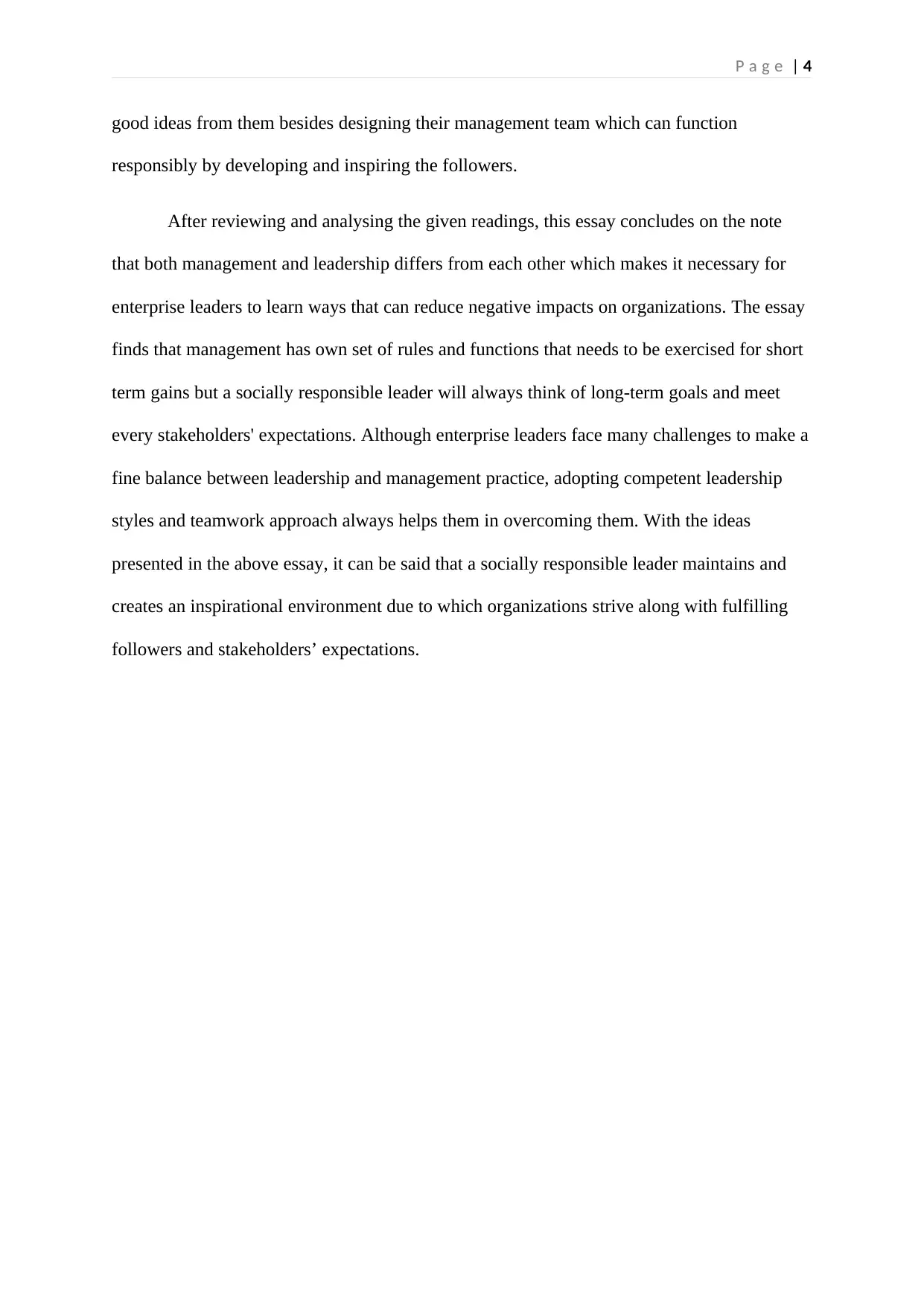
P a g e | 4
good ideas from them besides designing their management team which can function
responsibly by developing and inspiring the followers.
After reviewing and analysing the given readings, this essay concludes on the note
that both management and leadership differs from each other which makes it necessary for
enterprise leaders to learn ways that can reduce negative impacts on organizations. The essay
finds that management has own set of rules and functions that needs to be exercised for short
term gains but a socially responsible leader will always think of long-term goals and meet
every stakeholders' expectations. Although enterprise leaders face many challenges to make a
fine balance between leadership and management practice, adopting competent leadership
styles and teamwork approach always helps them in overcoming them. With the ideas
presented in the above essay, it can be said that a socially responsible leader maintains and
creates an inspirational environment due to which organizations strive along with fulfilling
followers and stakeholders’ expectations.
good ideas from them besides designing their management team which can function
responsibly by developing and inspiring the followers.
After reviewing and analysing the given readings, this essay concludes on the note
that both management and leadership differs from each other which makes it necessary for
enterprise leaders to learn ways that can reduce negative impacts on organizations. The essay
finds that management has own set of rules and functions that needs to be exercised for short
term gains but a socially responsible leader will always think of long-term goals and meet
every stakeholders' expectations. Although enterprise leaders face many challenges to make a
fine balance between leadership and management practice, adopting competent leadership
styles and teamwork approach always helps them in overcoming them. With the ideas
presented in the above essay, it can be said that a socially responsible leader maintains and
creates an inspirational environment due to which organizations strive along with fulfilling
followers and stakeholders’ expectations.
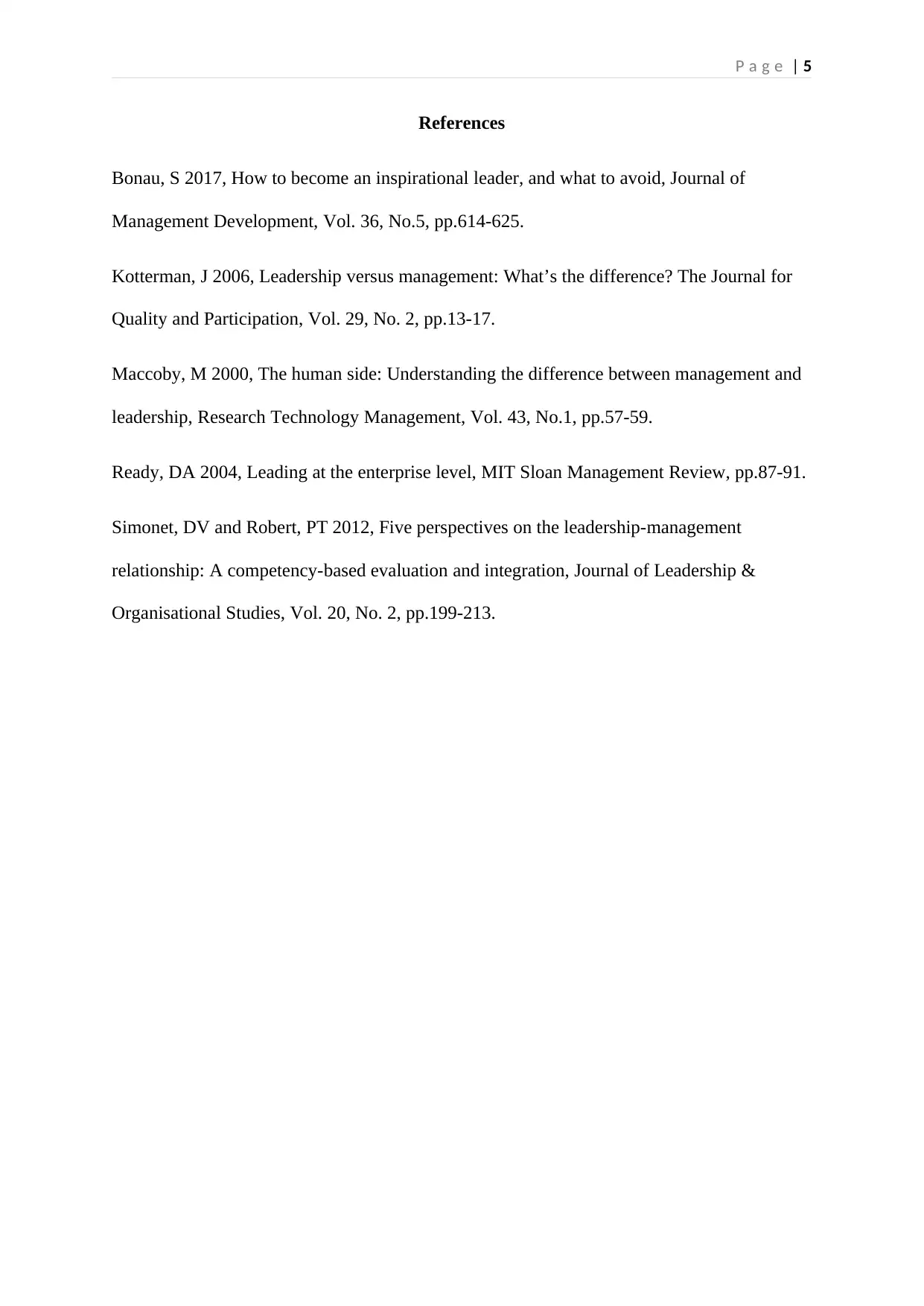
P a g e | 5
References
Bonau, S 2017, How to become an inspirational leader, and what to avoid, Journal of
Management Development, Vol. 36, No.5, pp.614-625.
Kotterman, J 2006, Leadership versus management: What’s the difference? The Journal for
Quality and Participation, Vol. 29, No. 2, pp.13-17.
Maccoby, M 2000, The human side: Understanding the difference between management and
leadership, Research Technology Management, Vol. 43, No.1, pp.57-59.
Ready, DA 2004, Leading at the enterprise level, MIT Sloan Management Review, pp.87-91.
Simonet, DV and Robert, PT 2012, Five perspectives on the leadership-management
relationship: A competency-based evaluation and integration, Journal of Leadership &
Organisational Studies, Vol. 20, No. 2, pp.199-213.
References
Bonau, S 2017, How to become an inspirational leader, and what to avoid, Journal of
Management Development, Vol. 36, No.5, pp.614-625.
Kotterman, J 2006, Leadership versus management: What’s the difference? The Journal for
Quality and Participation, Vol. 29, No. 2, pp.13-17.
Maccoby, M 2000, The human side: Understanding the difference between management and
leadership, Research Technology Management, Vol. 43, No.1, pp.57-59.
Ready, DA 2004, Leading at the enterprise level, MIT Sloan Management Review, pp.87-91.
Simonet, DV and Robert, PT 2012, Five perspectives on the leadership-management
relationship: A competency-based evaluation and integration, Journal of Leadership &
Organisational Studies, Vol. 20, No. 2, pp.199-213.
⊘ This is a preview!⊘
Do you want full access?
Subscribe today to unlock all pages.

Trusted by 1+ million students worldwide
1 out of 6
Related Documents
Your All-in-One AI-Powered Toolkit for Academic Success.
+13062052269
info@desklib.com
Available 24*7 on WhatsApp / Email
![[object Object]](/_next/static/media/star-bottom.7253800d.svg)
Unlock your academic potential
Copyright © 2020–2025 A2Z Services. All Rights Reserved. Developed and managed by ZUCOL.




